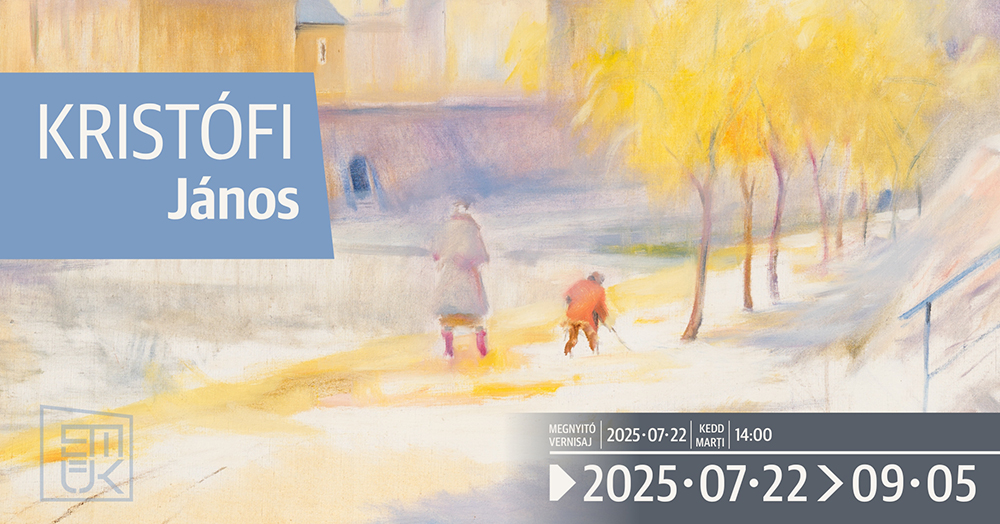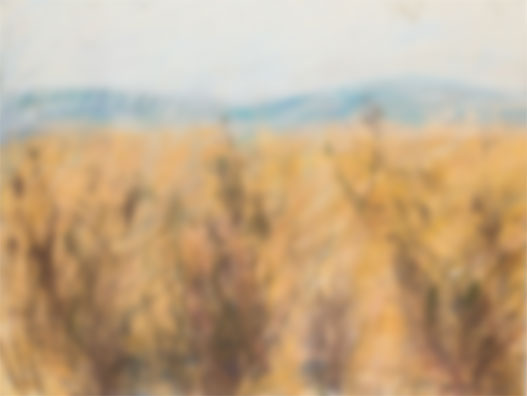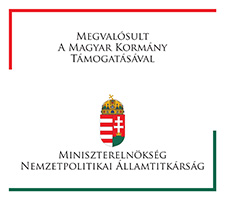 Visiting period: 22nd of July – 5th of September 2025
Visiting period: 22nd of July – 5th of September 2025
Opening: The exhibition was opened on the 22nd of July 2025 at 2 pm by Zsolt Németh, president of the Hungarian Foreign Affairs Council, Sándor Tamás, president of the Covasna County Council and Beáta Bordás PhD coordinator of the Transylvanian Art Centre. Collaborated: Ágnes Emese Kristófi (soprano) and Botond Szőcs (piano).
This exhibition presents around fifty paintings illustrating the periods and trends in János Kristófi’s work over several decades. The selection has focused on the artist’s main subjects, the cityscapes of Oradea and the views of his travels in Szeklerland and Hungary, but some of his early works (evoking the world of his native village) and some typical genre paintings were also included.
János KRISTÓFI (Petreu, 1925 – Oradea, 2014)
János Kristófi was born in a family of agricultors with five children, and his many-sided talent showed at a young age. He finished primary school in his home village, and in 1937 he began his secondary education at the Gojdu Lyceum in Oradea on a scholarship from the Roman Catholic Church, and took his final exam at Cluj in 1946. Between 1946-1949 he worked as a cantor and teacher in Carastelec. In 1949, he was admitted to the Hungarian Art Institute in Cluj (later the „Ion Andreescu” Institute of Fine Arts). As a pupil of Béla Abodi Nagy, Zoltán Kovács, Petre Abrudan and Sándor Mohy, he qualified as a drawing teacher at the Institute in 1954.
After graduation, he settled in Oradea. In 1956 he married the talented sculptor and ceramist, Judit Hoványi, between 1957 and 1973, ten children were born of their marriage. From 1955 until his retirement in 1986, János Kristófi was a teacher at the Oradea Popular Art School (now the Francisc Hubic School of Art), where he taught generations to love art and launched them on their artistic careers. The painter lived and worked in Oradea until his death on January 5, 2014.
From 1953 onwards he participated in numerous group exhibitions, and his first solo exhibition was held with his wife in Oradea in 1958. After that he organized a considerable number of solo exhibitions in Romania (mostly in Oradea) and abroad (repeatedly at the Hotel Gellért Tea Salon in Budapest). He participated in several art camps in Romania and Hungary, and his paintings reflect the landscapes he has visited in his life.
Kristófi’s style has multiple connections to the post-Nagybánya aspirations and Impressionism. He was a representative of naturalistic painting; in his paintings, light-saturated colours are combined with a naturalistic, yet individually transformed expression of the sights. According to art historian Zoltán Banner, Kristófi’s oeuvre – which is estimated at more than two thousand paintings – can be divided into two periods, and within them five themes, which at the same time were intertwined and intersected in his work. The first theme of his first period captures the rural landscape and people, above all his native village of Monospetri (Petreu); these works from the 1950s – 1960s were painted with earth tones and the drawing had a strong emphasis in them. A second theme, that of the urban landscape, centred of course on immortalizing Oradea, in a romantic light, but with the historic truthfulness of a documentarian spirit. He captured the places of his later travels also in this style crystalized at the end of the 1950s. The third theme in his painting was the World of the Studio and Art, and in the eighties and nineties he became interested in the artistic expression of anxiety and expectation, and then into a rapture of the soul probing into the future, these becoming the fourth theme of the painter’s life-work. The fifth, the sacral theme, permeated his entire oeuvre, since his first composition of St. Elizabeth in 1957.
Solo exhibitions (selection):
1958: Oradea (with Judit Hoványi) • 1963: Salonta, „Arany János” Memorial Museum • 1969: Valea lui Mihai; Oradea • 1970: Petreu; Marghita • 1975: Oradea, Small Gallery (with Judit Hoványi); Cluj-Napoca, Korunk Gallery • 1976: Miercurea Ciuc, Small Gallery; Oradea, Small Gallery • 1977: Debrecen (with Coriolan Hora); Oradea (with Judit Hoványi) • 1978: Dobrești • 1979: Oradea, „Fáklya” Gallery • 1980: Oradea, Criș Country Museum; Iași, Cupola Gallery • 1981: Satu Mare, Art Gallery; Carei, City Museum; Stockholm (with Judit Hoványi and Enikő Kristófi) • 1983: Tribute to Women – family exhibition, Oradea, New Gallery • 1984: Iași • 1985: Oradea, New Gallery • 1986: Marghita • 1987: Oradea, New Gallery (family exhibition); Satu Mare, Art Gallery • 1989: Miskolc, Mini Gallery; Oradea, Art Gallery; Brașov, editorial office of the „Brassói Lapok” newspaper (with Enikő Kristófi) • 1990: Győr, „Bartók Béla” House of Culture (family exhibition); Vienna; Leiben (AU); Budapest, Stefánia Gallery • 1991: Budapest, Adalbertinum; Kerepestarcsa (HU) • 1992: St. Pölten (with Judit Hoványi); Sopron (family exhibition); Oradea • 1993: Győr, Sopron and Oradea (with Enikő Kristófi) • 1994: Gödöllő (family exhibition) • 1995: Oradea, Gallery of the Roman Catholic Basilica; Oradea, Main Gallery • 1996: Oradea, Mini Gallery of the Fine Arts Fund • 1997: Oradea, Criș Country Museum (retrospective); Szeged, G Gallery; Kiskunfélegyháza (HU), the Garrison Club; Szolnok • 1998: Erlangen (DE); Oradea, Art Gallery; Cluj-Napoca, „Gy. Szabó Béla” Gallery • 1999: Șimleul Silvaniei, Hungarian Cultural Society of Transylvania; Budapest, Exhibition Hall „Nagy Balogh János”; Oradea, Art Gallery • 2000: Biharkeresztes (HU), „Bocskai István” High School; Leányfalu (HU), House of Culture; Budapest, Bank Center Gallery; Oradea, Small Gallery • 2001: Békés (HU), Museum; Oradea, Small Gallery; Budakeszi (HU), House of Culture • 2002: Odorheiu Secuiesc, Tourinfo; Miercurea Ciuc; Brașov; Târgu Mureș; Cluj-Napoca, Korunk Gallery; Salonta, „Arany János” Memorial Museum • 2003: Sopron, Transylvanian House • 2004: Budapest, Kamara Gallery; Szolnok, Garrison Club • 2005: Cluj-Napoca, Art Museum; Oradea, „Tibor Ernő” Gallery; Șimleul Silvaniei, Hungarian Cultural Society of Transylvania; Oradea, Criș Country Museum (retrospective) • 2006: Petreu; Marghita, Roman-Catholic church; Oradea, Seat of the Királyhágómellék Reformed Church District; Debrecen, Contemporary Art Gallery of the „Medgyessy Ferenc” Memorial Museum • 2007: Valea lui Mihai, Museum; Oradea, „Ady Endre” High School and Visual Arts Gallery • 2008: Oradea, Seat of the Királyhágómellék Reformed Church District, House of Culture, Visual Arts Gallery • 2009: Berettyóújfalu (HU), „Bihar Vármegye” Gallery; Oradea, the lobby of the „Arcadia” Puppet Theatre; Debrecen, „Belvárosi” Gallery • 2010, 2011: Oradea, Visual Arts Gallery • 2012: Oradea, Partium Christian University • 2013: Valea lui Mihai, Community Centre
Commemorative exhibitions:
2014: Oradea, Roman-Catholic Episcopal Palace and Criș Country Museum • 2015: Oradea, City Hall • 2016: Budapest, Duna Palace • 2019: Oradea, Fortress Gallery • 2024: Oradea, Roman-Catholic Episcopal Palace
Prizes and awards:
2005: Honorary citizen of Oradea • 2006: Honorary citizen of Petreu • 2011: Knight’s Cross of the Hungarian Order of Merit
Organizers: Sfântu Gheorghe City Hall, Transylvanian Art Centre Association
Sponsor: Hungarian Government – State Secretary for National Policy, Bethlen Gábor Fund, Grand Hotel Bálványos










